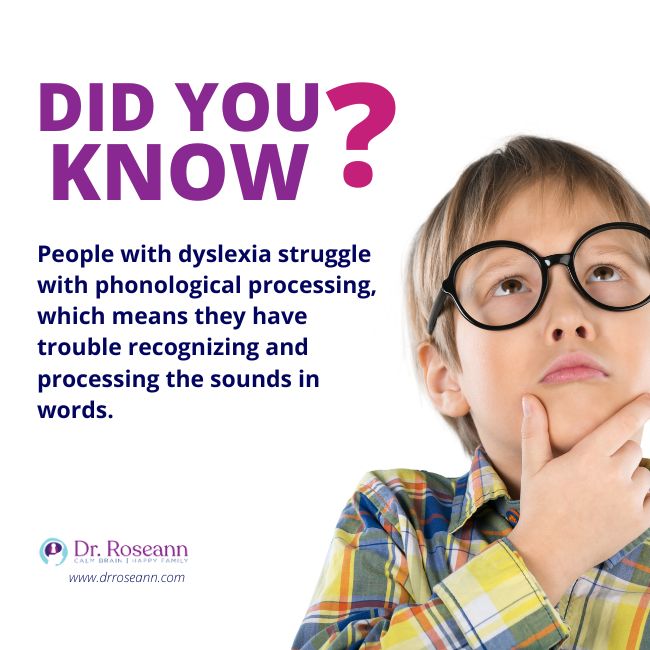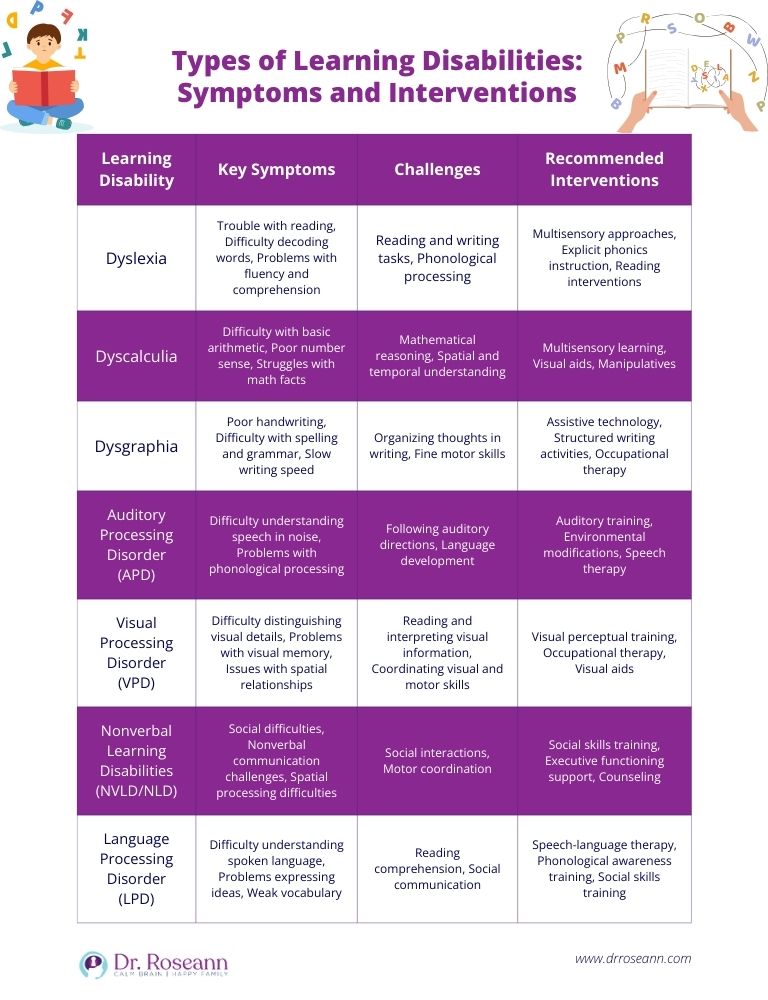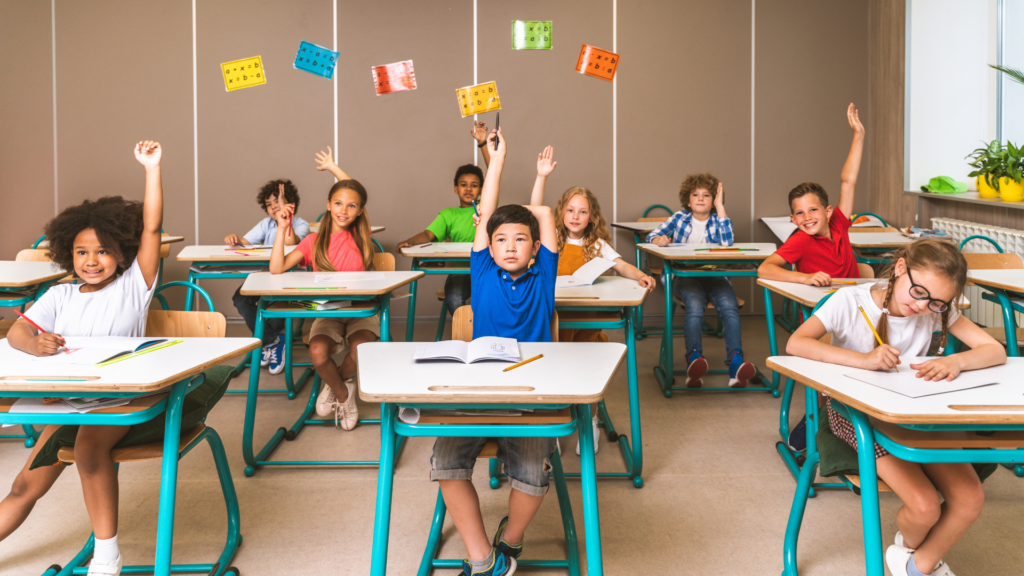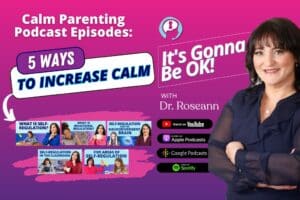Learning disabilities are neurological conditions that can affect the way individuals acquire, organize, store, and use information. There is a wide range of learning problems, and they can manifest in various ways.
My many years of experience in clinical psychology have shown me that there are more than seven learning disability types. Even so, there are seven main categories in this learning disabilities list which most others can be grouped under.
Another important thing to note about these disabilities that affect learning is that they’re not directly related to intelligence. In fact, many children with learning disabilities are more intelligent than the average kid.
Dyslexia
Dyslexia is a specific learning disability that primarily affects a person's ability to read, spell, and write. It is a neurological condition that is often hereditary and is not related to intelligence. Individuals with learning disorders like dyslexia may have difficulty with phonological processing, which involves recognizing and manipulating the sounds of spoken language

What are the Symptoms of the Learning Disorder Dyslexia?
Here are some key characteristics and challenges associated with dyslexia, which is most commonly referred to by many teachers as a reading and writing disability:
- Having trouble reading
- Slow and laborious reading
- Difficulty in accurately recognizing and decoding words
- Problems with fluency and comprehension
- Spelling Challenges
- Difficulty in spelling words correctly
- Inconsistent spelling patterns
- Writing Difficulties
- Challenges in organizing thoughts and expressing ideas in writing
- Poor handwriting or difficulty with fine motor skills
- Phonological Processing Issues
- Difficulty in recognizing and manipulating the sounds of spoken language
- Challenges with phonemic awareness, which involves understanding the smallest units of sound in words
- Difficulty with Sequencing
- Challenges in remembering the order of letters, numbers, or other sequences
- Directionality Confusion
- Difficulty learning left-right orientations and spatial awareness.
It's important to recognize that dyslexia is a lifelong condition, but with early intervention and appropriate support, children with dyslexia can develop effective reading and writing skills. Educational strategies that focus on multisensory approaches, explicit instruction in phonics, and accommodations can be beneficial for individuals with dyslexia.
Additionally, fostering a positive and supportive learning environment can enhance the academic success and confidence of individuals with dyslexia.
Dyscalculia
Dyscalculia is a specific learning disability that affects a person's ability to understand and work with numbers and mathematical concepts. Children with dyscalculia may struggle with learning various aspects of mathematics, from basic arithmetic to more advanced mathematical reasoning.
What are the symptoms of Dyscalculia?
Here are some signs and symptoms that will give you insight into what dyscalculia looks like:
- Difficulty with Basic Arithmetic
- Challenges in understanding and manipulating numbers for basic arithmetic operations like addition, subtraction, multiplication, and division.
- Poor Number Sense
- This learning disability causes difficulty in grasping the concept of quantity and understanding numerical relationships.
- Difficulty with Math Facts
- Struggles with memorizing and recalling basic math facts, such as multiplication tables
- Spatial and Temporal Challenges
- Difficulty understanding spatial relationships and concepts of time
- They may struggle with concepts like estimation and measurement
- Difficulty with Mathematical Reasoning
- Challenges in understanding and applying mathematical concepts beyond basic arithmetic
- Problems with Sequencing
- Difficulty with understanding and remembering the sequence of steps in mathematical procedures
- Visual-Spatial Challenges
- Difficulty in understanding and interpreting visual-spatial information related to mathematical problems
Interventions for dyscalculia typically involve a multisensory approach to learning, incorporating visual, auditory, and tactile elements. Teachers and support professionals may use manipulatives, visual aids, and other concrete examples to help individuals with dyscalculia grasp mathematical concepts.
Additionally, providing additional time for math-related tasks, breaking down complex problems into smaller steps, and offering alternative assessment methods can be helpful. Early identification and intervention are crucial to support individuals with dyscalculia in developing mathematical skills and confidence.
Dysgraphia
Dysgraphia is among the specific learning difficulties characterized by the inability to write. As such, a person with this condition can’t write coherently and efficiently. It involves difficulties with the physical act of writing, as well as challenges in organizing thoughts and expressing ideas in a written form.
What are the Symptoms of Dysgraphia?
Two famous people with dysgraphia are George Washington and Thomas Edison. Here are some symptoms commonly seen in kids with learning disabilities of this type:
- Poor Handwriting
- Messy, illegible handwriting is a common feature of dysgraphia
- Difficulty maintaining consistent size and spacing of letters and words
- Difficulty with Spelling
- Challenges in spelling words correctly, even if the person understands the spelling rules
- Problems with Grammar and Punctuation
- Difficulty with proper grammar usage and punctuation in written expression
- Slow Writing Speed
- Individuals with dysgraphia may write very slowly and may struggle to keep up with written assignments
- Difficulty with Organizing Thoughts
- Challenges in organizing ideas coherently in written form
- Difficulty with the overall structure of written compositions
- Fine Motor Skill Challenges
- Problems with fine motor skills that can affect tasks like holding a pencil or using scissors
- Inconsistency in Writing
- Inconsistency in the formation of letters and the overall appearance of written work.
Interventions for dysgraphia often involve a combination of strategies to address both the physical and organizational aspects of writing. The use of graphic organizers and assistive technology may help, particularly typing or speech-to-text software.
Approaches, where multisensory activities and structured writing activities are incorporated into their daily lives, may also work, as they improve their fine motor skills and reinforce letter formation. Explicit and individualized instruction in writing skills, including spelling and grammar rules will also help address their struggles.
Early identification and support are crucial for individuals with dysgraphia to develop effective writing skills and to succeed academically. Working closely with teachers, educational specialists, and possibly occupational therapists can help individuals with dysgraphia overcome challenges and build confidence in their writing abilities.

Auditory Processing Disorder (APD)
Auditory Processing Disorder (APD) is a neurological condition that affects the way the brain processes auditory information. Children with APD have difficulty interpreting and making sense of sounds, even though their hearing may be normal.
This disorder can impact various aspects of communication and learning. However, understand that APD is distinct from hearing impairment, as individuals with APD typically have normal hearing sensitivity.
What are the Symptoms of APD?
Here are some key characteristics and challenges associated with Auditory Processing Disorder:
- Difficulty Understanding Speech in Noisy Environments
- Individuals with APD may struggle to comprehend spoken language when there is background noise.
- Challenges with Auditory Discrimination
- Difficulty distinguishing between similar-sounding words or sounds.
- Difficulty Following Auditory Directions
- Challenges in understanding and following spoken instructions.
- Problems with Phonological Processing
- Difficulty recognizing and manipulating the sounds of spoken language, which can cause trouble in reading and spelling.
- Delayed or Impaired Language Development
- Some individuals with APD may experience delays in language development.
- Difficulty with Auditory Sequencing
- Challenges in remembering and repeating sequences of sounds or words.
- Sensitivity to Certain Sounds
- Hypersensitivity or hyposensitivity to specific sounds that impacts emotional and behavioral responses
Diagnosing APD involves a comprehensive assessment by an audiologist or other qualified professionals. Treatment for APD often involves a multidisciplinary approach, including educational strategies and interventions.
Some of the approaches that may be used are auditory training, which involves activities designed to strengthen auditory processing skills and improve the ability to interpret and analyze sounds; and environmental modifications, which entails removing background noise in learning environments.
Speech and language therapy is also recommended for children with APD as they target specific language and communication difficulties associated with the condition. IEPs are also necessary as they provide accommodations to modify learning tasks and support academic success.
Visual Processing Disorder
Visual Processing Disorder (VPD), also known as visual perception or visual information processing disorder, is a neurological condition that affects the way the brain interprets visual information. Children with VPD may have difficulty making sense of what they see, even though their eyesight may be normal. This can impact various aspects of daily life and learning.
What are the Symptoms of VPD?
Here are some key characteristics and challenges associated with Visual Processing Disorder:
- Visual Discrimination
- Difficulty distinguishing between similar-looking letters, numbers, or shapes
- Visual Figure-Ground Discrimination
- Challenges in picking out a specific image or object from a complex visual background
- Visual Memory Deficits
- This learning deficit involves difficulty remembering and recalling visual information, such as shapes, symbols, or faces.
- Spatial Relationships
- Challenges in understanding and interpreting spatial relationships, such as left-right orientation, distance, and size.
- Visual Closure
- Difficulty recognizing an object when only part of it is visible.
- Visual-Motor Integration
- Challenges in coordinating visual information with motor skills may affect tasks like handwriting and drawing.
- Visual Sequential Memory
- Learning disabilities with memory issues are often characterized by difficulty in remembering and reproducing a sequence of visual stimuli in the correct order.
- Eye-hand coordination
- Problems with activities that require precise coordination between vision and motor skills.
Diagnosing Visual Processing Disorder typically involves assessments conducted by professionals such as occupational therapists or developmental optometrists. Treatment and interventions for VPD may include Visual Perceptual Training and occupational therapy where activities designed to improve specific visual processing skills and exercises to enhance visual-motor coordination and fine motor skills are introduced. The use of visual aids can also provide tools and aids to support visual processing, such as magnifiers or colored overlays.
Nonverbal Learning Disabilities (NVLD or NLD)
Nonverbal Learning Disability (NVLD or NLD) is a neurological condition that affects nonverbal skills and abilities, as well as social functioning. Individuals with NVLD often have strengths in verbal abilities, but they may struggle with interpreting and understanding nonverbal cues, spatial relationships, and social interactions. There is a symptom overlap with autism and AuDHD.
NVLD is not officially recognized as a distinct diagnostic category in some diagnostic manuals, such as the DSM-5. However, many professionals and researchers recognize the unique challenges associated with NVLD.
What are the Symptoms of NVLD?
Here are some of the characteristics of kids who are learning disabled due to NVLD:
- Social Difficulties
- Challenges in understanding and interpreting social cues, such as body language and facial expressions
- Difficulty forming and maintaining friendships
- Nonverbal Communication Challenges
- Difficulty using and understanding nonverbal communication, including gestures and tone of voice
- Spatial Processing Difficulties
- Challenges with tasks that involve spatial relationships, such as reading maps or understanding geometric concepts
- Motor Coordination Challenges
- Difficulties with fine and gross motor skills, which may affect activities such as handwriting and sports
- Difficulty with Executive Functions
- Challenges in planning, organizing, and initiating tasks
- Difficulty with time management
- Literal Interpretation
- Tendency to interpret language in a very literal way, leading to potential misunderstandings.
- Strengths in Verbal Abilities
- Individuals with NVLD often have strong verbal skills, including reading, writing, and vocabulary.
- Difficulty with Transitions
- Struggles with transitions and changes in routine
It's important to conduct a comprehensive assessment by professionals such as neuropsychologists or educational psychologists to evaluate and diagnose Nonverbal Learning Disabilities. Interventions for NVLD may involve a multidisciplinary approach that includes social skills training and executive functioning support.
Counseling or psychotherapy is also important to provide emotional and behavioral support to help individuals cope with social challenges. Understanding and supporting individuals with Nonverbal Learning Disabilities involves recognizing their unique strengths and challenges.
Language Processing Disorder
Language Processing Disorder (LPD) is a language based learning disability that affects an individual's ability to understand and use language effectively. It involves difficulties in processing and interpreting spoken or written language, which can impact various aspects of communication. Like most other language based disability, LPD is not related to intelligence. Children with this disorder often have average to above-average intellectual abilities.
What are the Symptoms of Language Processing Disorder?
Learning-disabled children due to Language Processing Disorder usually exhibit these signs:
- Difficulty Understanding Spoken Language
- Challenges in comprehending and interpreting spoken words and sentences, especially in complex or fast-paced conversations
- Difficulty Expressing Ideas
- Struggling with expressing thoughts and ideas clearly and coherently, both verbally and in writing
- Literal Interpretation
- Tendency to interpret language very literally, which can lead to misunderstandings or difficulty grasping figurative language
- Phonological Processing Challenges
- Difficulty recognizing and manipulating the sounds of spoken language, which can impact reading and spelling
- Weak Vocabulary
- Limited vocabulary and challenges with word retrieval
- Difficulty Following Directions
- Challenges in understanding and following spoken or written instructions
- Problems with Reading Comprehension
- Difficulty understanding and extracting meaning from written texts
- Social Communication Difficulties
- Challenges in social interactions, including interpreting nonverbal cues, understanding humor, and engaging in reciprocal conversation
- Memory Challenges
- Difficulty remembering and recalling spoken or written information
- Struggles in Learning Foreign Languages
- Difficulty acquiring proficiency in additional languages
Diagnosing Language Processing Disorder typically involves a comprehensive assessment by speech-language pathologists, neuropsychologists, or other qualified professionals. Interventions may include phonological awareness training, social skills training, and speech-language therapy for learning disabilities.
What are learning disabilities?
Learning impairments or disabilities are neurodevelopmental disorders that affect an individual's ability to acquire, process, or express information in specific areas, despite having average to above-average intelligence. These disabilities impact the brain's ability to receive, process, store, respond to, and communicate information.
How many learning disabilities are there?
There isn't a fixed or exhaustive learning difficulties list, as the field of cognitive or learning disabilities is broad and encompasses various specific conditions. Different sources may categorize and name various learning disabilities differently.
What is the most commonly diagnosed learning disability?
Dyslexia is often considered the most common learning disability. However, dyslexia can vary in its presentation, and individuals with dyslexia may have strengths in other areas. Understanding learning disabilities like dyslexia necessitates a comprehensive and multi-dimensional strategy.
What is the most challenging of all childhood learning disabilities?
Dyslexia is often considered challenging because it affects reading and literacy skills, which are foundational to many aspects of academic learning. Reading difficulties can have a pervasive impact on various subjects and academic tasks.
What are dyslexia like disorders?
“Dyslexia-like disorders” is a term that is sometimes used to refer to conditions or difficulties that are similar to dyslexia but may not precisely meet the criteria for a dyslexia diagnosis. Examples of learning difficulties related to dyslexia are developmental reading disorder and specific learning disorder in reading.
What is specific learning disorder?
Specific Learning Disorder (SLD) is a neurodevelopmental disorder characterized by persistent difficulties in acquiring and using academic skills. These difficulties are not solely due to intellectual disabilities, sensory impairments, or inadequate instruction.
What are the most common learning disabilities in students?
Although not technically a cognitive learning disorder, ADHD is the cause of the most common learning difficulties experienced by students. Children with ADHD experience difficulty with sustaining attention, impulse control, and hyperactivity. They also face challenges in organizing tasks and managing time.
Which learning disability is characterized by unusual difficulty with reading?
Apart from dyslexia, another learning disability characterized by unusual difficulty with reading is a specific type of learning disability known as Specific Learning Disability in Reading or simply Reading Disorder.
What is the difference between learning disabilities and disorders?
Learning disabilities is a broad term encompassing a range of challenges affecting specific aspects of learning without necessarily implying a medical diagnosis. Learning disorders is sometimes used to refer to specific conditions with recognized diagnostic criteria.
Are dyslexia and learning difficulties the same?
No, dyslexia and learning difficulties are not the same, although dyslexia is a specific type of learning difficulty. The key distinction lies in the specificity of dyslexia as a recognized learning disorder with well-defined criteria, while learning difficulties is a broader term that encompasses a range of challenges in various aspects of learning.
Is dyslexia a mental disability?
No, dyslexia is not classified as a mental disability. It is a neurobiological condition characterized by difficulties with accurate and fluent word recognition and by poor spelling and decoding abilities.
Is a learning disability a mental disability?
A learning disability is a distinct category from a mental disability due to their difference in characteristics. Learning disabilities, such as dyslexia, involve challenges in specific areas of academic functioning, while mental disabilities, such as depression or anxiety disorders, affect broader aspects of mental health and emotional well-being.
How do learning disabilities affect students?
Learning disabilities and education don’t mix. Learning disabilities can significantly impact students in various ways, particularly with their academic performance, social interactions, and overall well-being.
How can you address learning disabilities in the classroom?
Addressing learning disabilities in the classroom involves early identification and assessment, the development of individualized plans such as IEPs or 504 Plans, and the implementation of differentiated instruction. Integrating assistive technology, providing a structured environment, and using multi-sensory teaching methods can further support students with learning disabilities.
Are learning disabilities in adults as common as learning disabilities in kids?
Yes, learning and cognitive disabilities can persist into adulthood, and they affect individuals throughout their lifespan. While learning disabilities are often identified during the school years when academic demands increase, they do not necessarily disappear with age. Undiagnosed learning disabilities in adults can present challenges in various aspects of life.
How to compare intellectual disability versus learning disability?
It’s relatively easy to compare intellectual disability vs learning disability. Intellectual disability is characterized by below-average intellectual functioning and limitations in adaptive behavior, with onset during the developmental period. Learning disabilities, in contrast, are neurological conditions that affect specific areas of learning, such as reading or math, despite normal intellectual functioning.
What causes learning difficulties?
Mild learning difficulties can stem from a combination of genetic, environmental, and neurological factors, including inherited predispositions, differences in brain structure or function, and exposure to toxins during prenatal development.
How to diagnose learning disability in children?
Depending on the severity of learning disability, the diagnosis of learning difficulties in a child involves a comprehensive process that includes observation, screening, input from parents and teachers, educational and psychological assessments, vision and hearing screenings, medical evaluations, and a review of the child's educational history. Most of these can be done by a learning disability psychologist.
Why do I have a learning disability?
The development of learning disabilities is often influenced by a combination of genetic, neurological, environmental, prenatal, and perinatal factors. These conditions are not a result of personal choices or behaviors and can be associated with differences in brain structure or function, genetic predispositions, or exposure to adverse conditions during pregnancy or birth.
How do you compare learning disability vs autism?
Learning disabilities focus on specific cognitive challenges, ASD encompasses a more comprehensive set of difficulties, including social interaction deficits, and learning and behavioral disabilities. Learning disabilities in autism refer to difficulties in acquiring specific academic skills or cognitive functions.
Is autism a learning disorder?
While autism and learning difficulties are similar, ASD is not classified as a learning disorder. ASD is a neurodevelopmental disorder characterized by challenges in social communication and the presence of restricted and repetitive behaviors, interests, or activities.
What does learning differences mean?
Learning differences is another word for learning disability. It is a term used to describe variations in the ways individuals learn and process information. It emphasizes the idea that people have diverse learning styles, strengths, and preferences.
Is nonverbal learning disorder on the autism spectrum?
Nonverbal Learning Disorder and Autism Spectrum Disorder are distinct neurodevelopmental conditions. However, ASD and learning difficulties share some similarities, particularly in social difficulties and nonverbal communication challenges.
I have a learning disability, now what?
If you have a severe learning disability, seek a professional diagnosis and explore support services. Develop personalized strategies, advocate for the kinds of special needs you require, and connect with support groups for guidance. Remember, resources are available to help you thrive despite challenges.
Is dyslexia a language based learning disability?
Yes, dyslexia is often described as a language-based learning disability. It primarily affects a person's ability to read, spell, and write, and it is related to trouble processing information related to language.
Citations:
Eisenmajer, N., Ross, N., & Pratt, C. (2005). Specificity and characteristics of learning disabilities. Journal of child psychology and psychiatry, and allied disciplines, 46(10), 1108–1115. https://doi.org/10.1111/j.1469-7610.2004.00394.x
Shaywitz, B. A., Fletcher, J. M., & Shaywitz, S. E. (1995). Defining and classifying learning disabilities and attention-deficit/hyperactivity disorder. Journal of child neurology, 10 Suppl 1, S50–S57. https://doi.org/10.1177/08830738950100S111
Tistarelli, N., Fagnani, C., Troianiello, M., Stazi, M. A., & Adriani, W. (2020). The nature and nurture of ADHD and its comorbidities: A narrative review on twin studies. Neuroscience and biobehavioral reviews, 109, 63–77. https://doi.org/10.1016/j.neubiorev.2019.12.017
Dr. Roseann is a mental health expert in Neurodivergence who frequently is in the media:
- Think Inclusive How Families Can Support Twice Exceptional Children
- The Elevated Podcast It's Going to Be OK!
- Natural Bliss Podcast The Link Between Physical & Mental Health in Children
NBC CT (Video) How to “Spring Clean” Your Mental Health
Always remember… “Calm Brain, Happy Family™”
Disclaimer: This article is not intended to give health advice and it is recommended to consult with a physician before beginning any new wellness regime. *The effectiveness of diagnosis and treatment vary by patient and condition. Dr. Roseann Capanna-Hodge, LLC does not guarantee certain results.
Are you looking for SOLUTIONS for your struggling child or teen?
Dr. Roseann and her team are all about science-backed solutions, so you are in the right place!
Grab your complimentary copy of
147 Therapist-Endorsed Self-Regulation Strategies for Children: A Practical Guide for Parents
Dr. Roseann is a Children’s Mental Health Expert and Licensed Therapist who has been featured in/on hundreds of media outlets including The Mel Robbins Show, CBS, NBC, PIX11 NYC, Today, FORBES, CNN, The New York Times, The Washington Post, Business Insider, Women’s Day, Healthline, CNET, Parade Magazine and PARENTS. FORBES called her, “A thought leader in children’s mental health.”

She coined the terms, “Re-entry panic syndrome” and “eco-anxiety” and is a frequent contributor to media on mental health.
Dr. Roseann Capanna-Hodge has three decades of experience in working with children, teens and their families with attention-deficit hyperactivity disorder (ADHD), autism, concussion, dyslexia and learning disability, anxiety, Obsessive Compulsive Disorder (OCD), depression and mood disorder, Lyme Disease, and PANS/PANDAS using science-backed natural mental health solutions such as supplements, magnesium, nutrition, QEEG Brain maps, neurofeedback, PEMF, psychotherapy and other non-medication approaches.
She is the author of three bestselling books, It’s Gonna Be OK!: Proven Ways to Improve Your Child's Mental Health, The Teletherapy Toolkit, and Brain Under Attack. Dr. Roseann is known for offering a message of hope through science-endorsed methods that promote a calm brain.
Her trademarked BrainBehaviorResetⓇ Program and It’s Gonna be OK!Ⓡ Podcast has been a cornerstone for thousands of parents facing mental health, behavioral or neurodevelopmental challenges.
She is the founder and director of The Global Institute of Children’s Mental Health, Neurotastic™Brain Formulas and Dr. Roseann Capanna-Hodge, LLC. Dr. Roseann is a Board Certified Neurofeedback (BCN) Practitioner, a Board Member of the Northeast Region Biofeedback Society (NRBS), Certified Integrative Mental Health Professional (CIMHP) and an Amen Clinic Certified Brain Health Coach. She is also a member of The International Lyme Disease and Associated Disease Society (ILADS), The American Psychological Association (APA), Anxiety and Depression Association of America (ADAA) National Association of School Psychologists (NASP), International OCD Foundation (IOCDF).
© Roseann-Capanna-Hodge, LLC 2024










